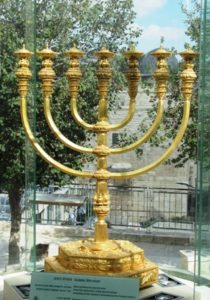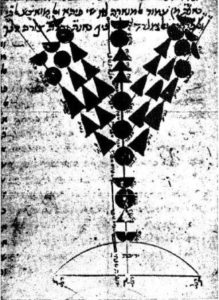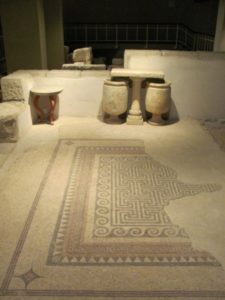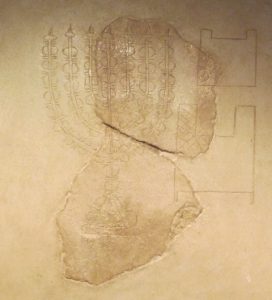The Parashot preceding Parashat Terumah – Jethro and Mishpatim are very dramatic. Moses on Mt. Sinai, The Ten Commandments, the Golden Calf, fire, Pillar of cloud, and the voice of God. After these dramatic events we find in Parashat Terumah a description of an ordinary day. Moses is commanded by God to build the Tabernacle using donations from the Israelites. The Tabernacle is to be a man-made tent made of sea cows skins. This command is follow by a detailed description of the Tabernacle and it’s content and tools – God forbids Moses to change any of the instructions given – ” Make this tabernacle and all its furnishings exactly like the pattern I will show you” (Exodus, 25, 9) . Sometimes, while reading this chapter I feel as if it is the most ordinary request. It resembles giving a description to a craftsman in order to get an artifact without allowing him to take part in the process and improvise or ad some ideas of his own. As I said already – just another ordinary day.
In addition to the Tabernacle God give the order to make the Ark of Covenant, the Menorah, the Mercy seat and the table of showbread. It is very interesting to notice that the Menorah is the only one of these artifacts that became known all over the world as the symbol for Judaism. The Menorah as a symbol became important already during the Byzantine period. The other well known symbol – The Star of David – started to gain importance only during the 19th century.
Allegedly we can find in Parashat Terumah a reliable description of the Menorah that used to stand in the Tabernacle and later in the temple in Shiloh and in the one in Jerusalem: ” Six branches are to extend from the sides of the lampstand—three on one side and three on the other. Three cups shaped like almond flowers with buds and blossoms are to be on one branch, three on the next branch, and the same for all six branches extending from the lampstand” (Exodus, 25, 32-33). The full description is even more detailed but it leaves us wondering about many aspects of its appearance: How did the base of the Menorah look like? How do flowers with buds look like? Were the branches of the Menorah straight or bent? If it only stayed one of many artifacts in the Temple I suppose the above questions would interest only a small group of people deeply invested in the Halacha, however the Menorah is much more then an artifact of the Temple and the debate about it’s appearance became an issue of interest all over the Jewish world. Many words were written about the issue and every important adjudicator referred to the question. Maimonides for example thought that the branches of the Menorah were straight and even added a small doodle to explain his opinion about the appearance of the Menorah. We who would like to learn more about this debate have to go and walk the streets of Jerusalem in order to see for ourselves.
The most ancient references we have of the Menorah are from the second Temple period. Prof. Israel L. Levine lists in his article about the Menorah and it’s meaning four references. The most interesting reference in my opinion is the one found in the excavations of the upper city of Jerusalem by Nahman Avigad after the Six-day war. This was the golden age of Israeli archeology. Archeologists like Yigael Yadin becam well known celebrities and the newspaper headline often dealt with the amazing discoveries that were made in the different sites. The most celebrated excavation of the time was the extensive excavations of Nahman Avigad in the Jewish quarter of the old city of Jerusalem. Avigad uncovered the Broad Wall and the Cardo but also the houses of the upper city of Jerusalem. Only four meters under the houses of the present Jewish quarter Avigad uncovered the houses of the high society of Jerusalem among them were many priests. These people lived in Jerusalem in the Herodian period and to be more accurate towards the end of the first century B.C. The findings were spectacular: great houses, ritual baths and magnificent mosaics a glass vase made in the workshop of well known Sidon craftsman ‘ennion’ and much more. You can find most of the artifacts when visiting the Herodian quarter site in the heart of the Jewish quarter.
Even though almost every exhibit in the site is interesting I suggest we turn our attention to an artistic engraving made on plaster. The engraving was found on a wall in one of the houses of the quarter. The exhibit shown in the Herodian quarter these days is a replica. The original is exhibited in the Israel museum. This engraving is one of the most ancient references to the Menorah. It was made by a man that most probably saw the original Menorah that stood in the heart of the Herodian Temple in Jerusalem. The size of the engraving is about 20cm. It has branches bent into a U shape and its base is sort of triangular. The shape of the flowers with buds is a circle and there are no candles. Because of the fact that this is a-2000 years old description of a Menorah one can think that it looks exactly like the one that god commended Moses to build. But the fact is the image of this Menorah is very different from the one found on the arch of Titus in Rome that was also made by a man who might saw the original Menorah. The main difference is in the base of the Menorah which was replaced probably by the Romans after taking the Menorah as war plunder after 70B.C. and the destruction of the Temple.
It is interesting to notice that when looking for an Emblem for the new state of Israel it was decided to choose the Arch of Titus Menorah. According to the tradition the Menorah from the arch of Titus was considered for a long time a symbol for the distraction of the Temple and Israel. The Jews of Rome refused to walk under the arch of Titus for shame. After the Menorah of the arch of Titus was adopted as the Israeli emblem it became a Zionist symbol – a symbol of hope and revival. If you want to learn a little about the process of choosing an Israeli emblem you are invited to take a tour in the Zionist archive in Jerusalem. The archive resides in Talpiyot neighborhood. Another place to visit is the Tower of David museum that holds a replica of the relevant part of the arch of Titus.
He who exits the Herodian quarter and is still interested in the Menorah can turn right, walk down a few steps in the stairs leading to the Western Wall and take a look at the Menorah Model made and placed their by the people of the Temple institute. The Temple institute was established in 1987 and its people encourage the debate about the building of a third Temple hoping it will come true. As a part of their mission the people of the Temple institute study thoroughly many aspects of God’s worship practices and try to address Halacha issues they encounter. It would be no surprise then that they take great interest in the Menorah. After studying the subject for a long fruitful time they created an impressive model of the Menorah and placed it in the middle of the Cardo. After a few years it was transferred to its current location. This Menorah is dramatically different from the Menorah engraving found in the Herodian quarter, just a few meters from there. This is Jerusalem it always welcomes different interpretations that dwell together.



